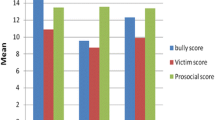Abstract
Violence and aggression amongst adolescents is increasing across the globe. However, the research on adolescent violence in India is limited. The present study was undertaken to study aggressive beliefs, attitudes, behavior rural schools in north district of Delhi. It was a cross-sectional study conducted among adolescents studying in grade VIII–X in three rural schools in Delhi, selected by non-probability sampling. The data was collected using a questionnaire adapted from CDC Compendium of tools measuring aggression. Out of the total 270 adolescents, there were 119 boys (44.1%) and 151 (55.9%) girls. The mean score of beliefs, attitude aggressive behaviour for private co-ed school was highest while all girls’ school had lowest (p < 0.001). Being male (p < 0.001), studying in private co-ed school (p < 0.001) and having attitude towards violence (p = 0.02) contributed significantly to total aggression score. The study highlighted that type of school, gender and attitudes influence adolescents’ behavior towards aggression.

Similar content being viewed by others
References
Allen, J. A., & Anderson, C. A. (2015). Aggression and violence: Definitions and distinctions. Retrieved from http://public.psych.iastate.edu/caa/abstracts/2015-2019/16AA.pdf.
Anderson, C. A., & Heusmann, L. R. (2003). Human aggression: A social analytical view. In A. Michael Hogg & Joel Cooper (Eds.), The Sage handbook of social psychology. Thousand Oaks: Sage Publications, Inc.
Archer, J., & Haigh, A. (1997). Do beliefs about aggressive feelings and actions predict reported levels of aggression? British Journal of Social Psychology, 36, 83–105.
Australian Research Alliance for Children & Youth. (2010). Preventing youth violence. What does and doesn’t work and why? Melbourne: ARACY.
Bandura, A. (1973). Aggression: A social learning analysis. Englewood Cliffs, NJ: Prentice-Hall.
Bjorkqvist, K., Osterman, K., Oommen, T. K., & Lagerspertz, K. M. J. (2001). Physical, verbal and indirect aggression among Hindu, Muslim and Sikh adolescents in India. In M. Martinez (Ed.), Prevention and control of aggression and the impact on its victims. New York: Kluwer Academic Publisher.
CDC. (2005). Measuring violence related attitudes, behaviours and influences among youths: A compendium of assessment tools (2nd edn.). Atlanta: CDC.
Chapter-6: Education. (2010). Retreived from http://delhi.gov.in/wps/wcm/connect/aa73eb80486863e7895acfe83e6e4488/Chapter6.pdf?MOD=AJPERES.
Elamsry, N. M., Fouad, A. A., Khalil, D. M., & Sherra, K. S. (2016). Physical and verbal aggression among adolescent school students in Sharkia, Egypt: Prevalence and risk factors. Egyptian Journal of Psychiatry, 37, 166–173.
Finigan-Carr, N. M., Gielen, A., Haynie, D. L., & Cheng, T. L. (2015). Youth violence: How gender matters in aggression among urban early adolescents. Journal of Interpersonal Violence. https://doi.org/10.1177/0886260515584348.
Houston Community Demonstration Project. (1983). Peer leader survey. Houston, TX: City of Houston Health and Human Services Department (Unpublished).
Huesmann, L. R., & Guerra, N. G. (1997). Children’s normative beliefs about aggression and aggressive behavior. Journal of Personality and Social Psychology, 72, 408–419.
Kumar, M., Bhilwar, M., Kapoor, R., Sharma, P., & Ojha, P. (2016). Prevalence of aggression among school going adolescents in India: A review study. Indian Journal of Youth and Adolescent Health, 3(4), 39–47.
Loeber, R., & Pardini, D. (2008). Neurobiology and the development of violence: Common assumptions and controversies. Philosophical Transactions of the Royal Society B: Biological Sciences, 363(1503), 2491–2503.
Mahajan, S., Arora, A. K., Gupta, P., & Kapoor, S. (2011). Adolescent Violence: An emerging issue. Journal of Punjab Academy of Forensic Medicine & Toxicology, 11(1), 34–36.
Orpinas, P., & Frankowski, R. (2001). The aggression scale: A self-report measure of aggressive behavior for young adolescents. Journal of Early Adolescence, 21(1), 51–68.
Orpinas, P., Horne, A. M., & Staniszewski, D. (2003). School bullying: Changing the problem by changing the school. School Psychology Review, 32(3), 431–444.
Owusu-Banahene, N. O., & Amedahe, F. K. (2008). Adolescent students’ beliefs about aggression and the association between beliefs and reported level of aggression: A study of senior high school students in Ghana. Australian Journal of Educational and Developmental Psychology, 8, 64–71.
Parke, R. D., & Slaby, R. G. (1983). The development of aggression. In P. H. Mussen, & E. M. Hetherington (Eds.), Handbook of child psychology, Vol. 4. Socialization, personality, and social development (pp. 547–641). New York, NY: Wiley.
Ray, M., & Malhi, P. (2006). Adolescent violence exposure, gender issues and impact. Indian Pediatrics, 43(7), 607–612.
Sharma, R., Grover, V. L., & Chaturvedi, S. (2008). Risk behaviors related to Inter-personal violence among school and college going adolescents in south Delhi. Indian Journal of Community Medicine, 33(2), 85–88.
Slaby, R. G., & Guerra, N. G. (1988). Cognitive mediators of aggression in adolescent offenders: I. Assessment. Developmental Psychology, 24(4), 580–588.
Sunitha, S., & Gururaj, G. (2014). Health behaviours & problems among young people in India: Cause for concern & call for action. The Indian Journal of Medical Research, 140(2), 185–208.
WHO. (2002). World report on violence and health: summary. Geneva: WHO.
WHO. (2009). Violence prevention the evidence. Changing cultural and social norms that support violence. Geneva: WHO.
WHO. (2016 November 15). Adolescent health epidemiology. Retreived from http://www.who.int/maternal_child_adolescent /epidemiology/adolescence/en/.
Author information
Authors and Affiliations
Contributions
TA, Assistant Professor, Department of Community Medicine, contributed in preparation of protocol, literature search data analysis and its interpretation, and drafting the report. JK, Director Professor, Department of Community Medicine, conceptualized the idea for this study. He guided in preparation of protocol, questionnaire, data collection, analysis, writing and reviewing of the report. SG, Scientist B, NICPR, contributed in data collection, entry and statistical analysis of the data and writing of the report. SB, Director, AACCI, guided in preparation of protocol, questionnaire, and reviewing of the report. SY, Director Professor & Head, Department of Paediatrics, guided in preparation of protocol, questionnaire, and reviewing of the report.
Corresponding author
Ethics declarations
Conflict of interest
All the authors declare that they have no conflict of interest.
Rights and permissions
About this article
Cite this article
Anand, T., Kishore, J., Grover, S. et al. Beliefs Supporting Violence, Attitudes and Aggressive Behavior Among School Adolescents in Rural Delhi. Community Ment Health J 55, 693–701 (2019). https://doi.org/10.1007/s10597-018-0315-z
Received:
Accepted:
Published:
Issue Date:
DOI: https://doi.org/10.1007/s10597-018-0315-z




